Lecture 4 emotion a conscious evaluative


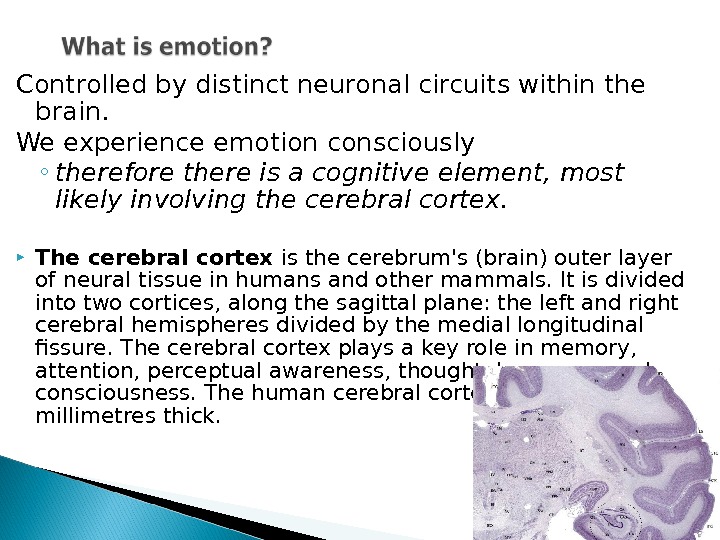






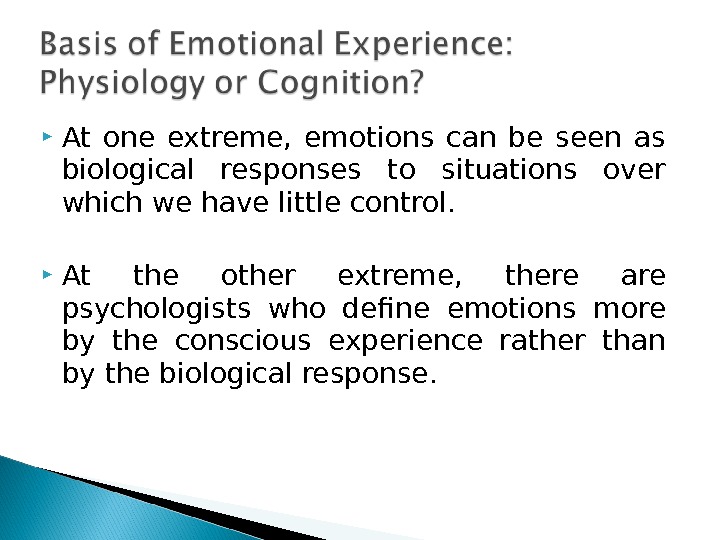



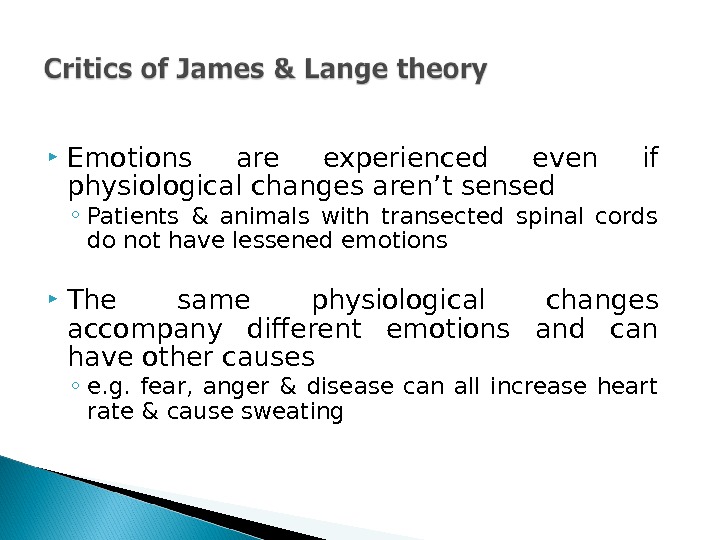



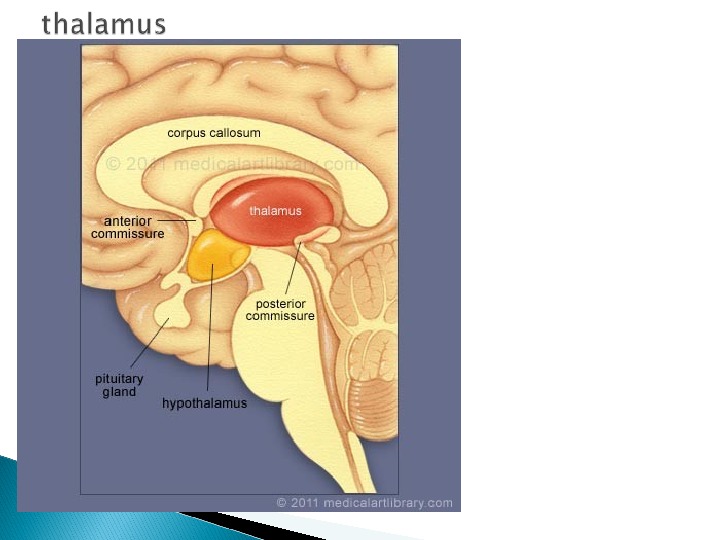
















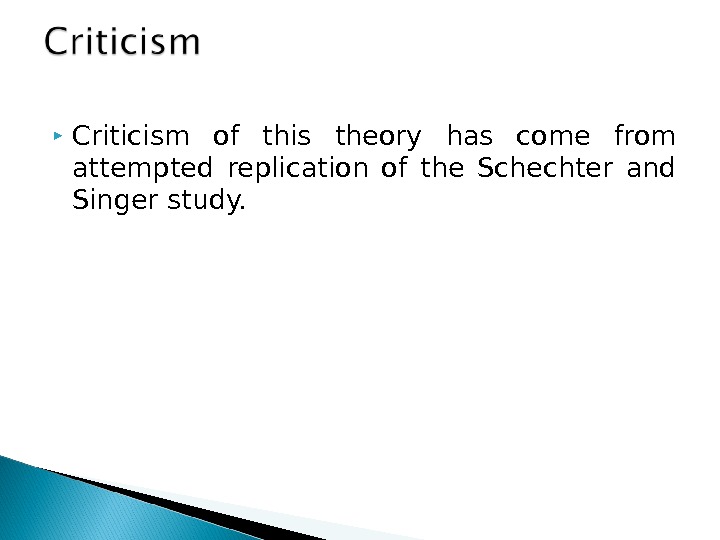
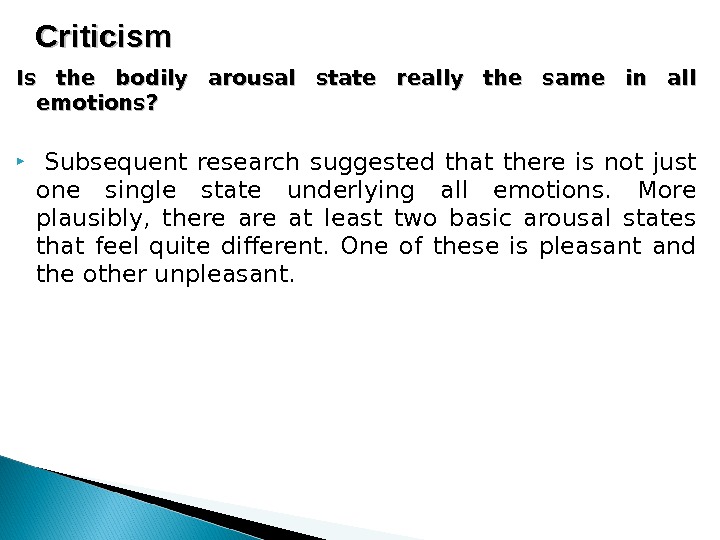

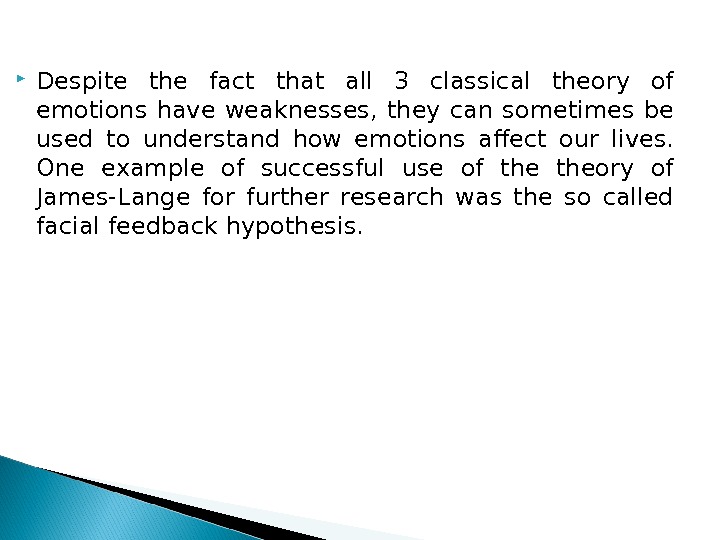


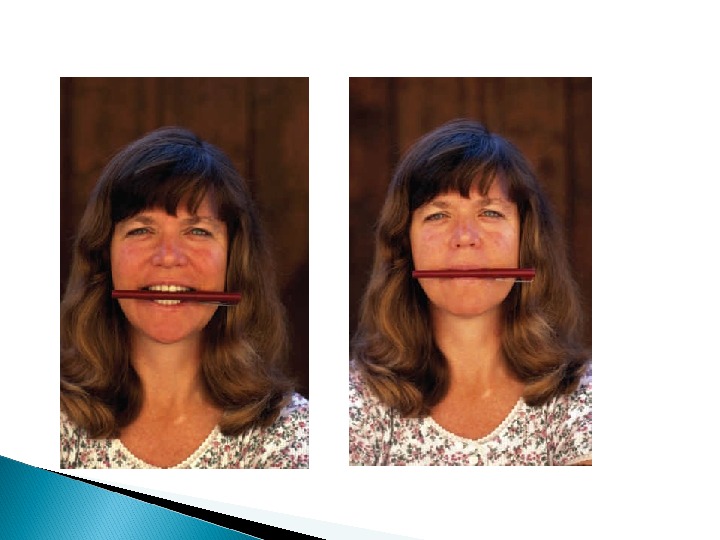



- Размер: 3.9 Mегабайта
- Количество слайдов: 44
Описание презентации Lecture 4 emotion a conscious evaluative по слайдам
 Lecture
Lecture
 emotion a conscious evaluative reaction to some event mood a feeling state that is not clearly linked to some event affect the automatic response that something is good or bad
emotion a conscious evaluative reaction to some event mood a feeling state that is not clearly linked to some event affect the automatic response that something is good or bad
 Controlled by distinct neuronal circuits within the brain. We experience emotion consciously ◦ therefore there is a cognitive element, most likely involving the cerebral cortex. The cerebral cortex is the cerebrum’s (brain) outer layer of neural tissue in humans and other mammals. It is divided into two cortices, along the sagittal plane: the left and right cerebral hemispheres divided by the medial longitudinal fissure. The cerebral cortex plays a key role in memory, attention, perceptual awareness, thought, language, and consciousness. The human cerebral cortex is 2 to 4 millimetres thick.
Controlled by distinct neuronal circuits within the brain. We experience emotion consciously ◦ therefore there is a cognitive element, most likely involving the cerebral cortex. The cerebral cortex is the cerebrum’s (brain) outer layer of neural tissue in humans and other mammals. It is divided into two cortices, along the sagittal plane: the left and right cerebral hemispheres divided by the medial longitudinal fissure. The cerebral cortex plays a key role in memory, attention, perceptual awareness, thought, language, and consciousness. The human cerebral cortex is 2 to 4 millimetres thick.
 Emotion can be viewed as an outcome of the interaction of ◦ neural & hormonal responses to perceptions (feelings) ◦ a cognitive appraisal of the situation arousing the state ◦ an outward expression of the state
Emotion can be viewed as an outcome of the interaction of ◦ neural & hormonal responses to perceptions (feelings) ◦ a cognitive appraisal of the situation arousing the state ◦ an outward expression of the state
 Emotions ◦ determine personal viability ◦ prepare us for action ◦ shape our behavior ◦ regulate social interaction ◦ facilitate communication nonverbally ◦ facilitate adult-child relations and thus development ◦ allow us to respond flexibly to our environment (approaching good, avoiding bad)
Emotions ◦ determine personal viability ◦ prepare us for action ◦ shape our behavior ◦ regulate social interaction ◦ facilitate communication nonverbally ◦ facilitate adult-child relations and thus development ◦ allow us to respond flexibly to our environment (approaching good, avoiding bad)

 Ways to Measure Emotion • Body/Physical – blood pressure – heart rate – adrenaline levels – muscle activity when smiling, frowning, etc. – neural images – posture – tears, – perspiration – lie detector readings
Ways to Measure Emotion • Body/Physical – blood pressure – heart rate – adrenaline levels – muscle activity when smiling, frowning, etc. – neural images – posture – tears, – perspiration – lie detector readings
 Ways to Measure Emotion • Thoughts (observed indirectly through) – spoken and written words on rating scales – answers to open-ended questions on surveys and during interviews – responses to projective instruments
Ways to Measure Emotion • Thoughts (observed indirectly through) – spoken and written words on rating scales – answers to open-ended questions on surveys and during interviews – responses to projective instruments
 Ways to Measure Emotion • Behavior – facial expressions – activity level – alertness – screaming – laughing – smiling – aggression – attention/distraction – insomnia
Ways to Measure Emotion • Behavior – facial expressions – activity level – alertness – screaming – laughing – smiling – aggression – attention/distraction – insomnia
 At one extreme, emotions can be seen as biological responses to situations over which we have little control. At the other extreme, there are psychologists who define emotions more by the conscious experience rather than by the biological response.
At one extreme, emotions can be seen as biological responses to situations over which we have little control. At the other extreme, there are psychologists who define emotions more by the conscious experience rather than by the biological response.
 Theorists such as William James and Carl Lange suggest that emotional experience is a direct result of physiological arousal. So, for them arousal is a cause the emotion; while for others, such arousal is a signal system for the brain to act and produce emotions (Cannon)
Theorists such as William James and Carl Lange suggest that emotional experience is a direct result of physiological arousal. So, for them arousal is a cause the emotion; while for others, such arousal is a signal system for the brain to act and produce emotions (Cannon)
 Proposed that the experience we call emotion occurs after the cortex receives signals about physiologic changes ◦ Emotional expression precedes emotional experience ◦ Physiological changes occur in response to stimuli, then we feel emotions The body informs the mind (“we know we are sad because we cry”) Distinctive body changes/symptoms are accompanied by different emotions Perception of these changes/symptoms determines the experience of emotion Differences between emotions are a direct result of the different patterns of physiological response associated with them
Proposed that the experience we call emotion occurs after the cortex receives signals about physiologic changes ◦ Emotional expression precedes emotional experience ◦ Physiological changes occur in response to stimuli, then we feel emotions The body informs the mind (“we know we are sad because we cry”) Distinctive body changes/symptoms are accompanied by different emotions Perception of these changes/symptoms determines the experience of emotion Differences between emotions are a direct result of the different patterns of physiological response associated with them

 Emotions are experienced even if physiological changes aren’t sensed ◦ Patients & animals with transected spinal cords do not have lessened emotions The same physiological changes accompany different emotions and can have other causes ◦ e. g. fear, anger & disease can all increase heart rate & cause sweating
Emotions are experienced even if physiological changes aren’t sensed ◦ Patients & animals with transected spinal cords do not have lessened emotions The same physiological changes accompany different emotions and can have other causes ◦ e. g. fear, anger & disease can all increase heart rate & cause sweating
 Cannon argues the James-Lange theory is too slow in accounting for instantaneous emotional feeling. Emotional encounters are emergency situations which directly trigger a central brain process in the thalamus. Which lead to two simultaneous but independent outcomes: ◦ heightened arousal system which prepares the body to cope with the emergency ◦ the conscious experience of the emotion is registered in the cortex
Cannon argues the James-Lange theory is too slow in accounting for instantaneous emotional feeling. Emotional encounters are emergency situations which directly trigger a central brain process in the thalamus. Which lead to two simultaneous but independent outcomes: ◦ heightened arousal system which prepares the body to cope with the emergency ◦ the conscious experience of the emotion is registered in the cortex
 The thalamus plays a central role in their theory. The thalamus is the part of the brain that is like a relay station for nerve impulses. Information from the emotional stimulus goes to the thalamus. From there, the information is relayed both to the cerebral cortex, which produces the experience of emotion, and to the hypothalamus and autonomic nervous system, which produce the increase in physiological arousal. Cannon & Bard Theory of Emotion
The thalamus plays a central role in their theory. The thalamus is the part of the brain that is like a relay station for nerve impulses. Information from the emotional stimulus goes to the thalamus. From there, the information is relayed both to the cerebral cortex, which produces the experience of emotion, and to the hypothalamus and autonomic nervous system, which produce the increase in physiological arousal. Cannon & Bard Theory of Emotion
 The thalamus (from Greek θάλαμος, «chamber») is a midline symmetrical structure of two halves, within the vertebrate brain, situated between the cerebral cortex and the midbrain. Some of its functions are the relaying of sensory and motor signals to the cerebral cortex, and the regulation of consciousness, sleep, and alertness.
The thalamus (from Greek θάλαμος, «chamber») is a midline symmetrical structure of two halves, within the vertebrate brain, situated between the cerebral cortex and the midbrain. Some of its functions are the relaying of sensory and motor signals to the cerebral cortex, and the regulation of consciousness, sleep, and alertness.


 Suppose that you are walking down a dark alley in a dangerous part of town late one night, and you hear footsteps behind you. According to the Cannon–Bard theory of emotion , the thalamus will send two messages at the same time: one message that makes you feel afraid another message that produces an increase in physiological arousal (e. g. , heart rate, breathing rate).
Suppose that you are walking down a dark alley in a dangerous part of town late one night, and you hear footsteps behind you. According to the Cannon–Bard theory of emotion , the thalamus will send two messages at the same time: one message that makes you feel afraid another message that produces an increase in physiological arousal (e. g. , heart rate, breathing rate).


 Suggest we recognise different emotions because of our mental evaluations of our current situation. Schachter & Singer two-factor theory. Emphasised the importance of both physiological and situational factors in determining emotion. They called this the two-factor theory of emotions. According to them emotions are the result from the psychological arousal as well as the cognitive appraisal of the situation.
Suggest we recognise different emotions because of our mental evaluations of our current situation. Schachter & Singer two-factor theory. Emphasised the importance of both physiological and situational factors in determining emotion. They called this the two-factor theory of emotions. According to them emotions are the result from the psychological arousal as well as the cognitive appraisal of the situation.
 The basis of theory suggested that autonomic arousal provided the energy and intensity of an emotion. In other words physiological arousal by itself could determine the quantity but not the quality of arousal Schachter and Singer proposed an element of cognitive attribution as the critical factor in emotional experience We evaluate the situation in terms of recognising what emotion we should be experiencing
The basis of theory suggested that autonomic arousal provided the energy and intensity of an emotion. In other words physiological arousal by itself could determine the quantity but not the quality of arousal Schachter and Singer proposed an element of cognitive attribution as the critical factor in emotional experience We evaluate the situation in terms of recognising what emotion we should be experiencing
 The labelling of arousal depends on an attribution which is the processes of identifying the cause of some events. People may attribute their physiological arousal to different emotion. Depending on the available information, especially about the situation.
The labelling of arousal depends on an attribution which is the processes of identifying the cause of some events. People may attribute their physiological arousal to different emotion. Depending on the available information, especially about the situation.
 If some one is watching the final moments of a crucial football match then he may attribute his rapid breathing, racing heart and perspiration to excitement, but the same physiological changes may be attribute to anxiety if the person is waiting for an important exams to begin. So, emotion depends how we label our reaction.
If some one is watching the final moments of a crucial football match then he may attribute his rapid breathing, racing heart and perspiration to excitement, but the same physiological changes may be attribute to anxiety if the person is waiting for an important exams to begin. So, emotion depends how we label our reaction.



 Participants were told that the researchers were studying the “effects of vitamin injections on visual skills. ” Then, participants received an injection of either adrenaline (epinephrine) or a placebo (saline solution, which has no effects; it was included just to control for any effects of having someone stick a needle into your arm). Adrenaline is a stimulant that causes your heart rate, blood pressure, and breathing rate to increase. Participants who received the adrenaline shot were either informed or not informed about the “side effects” of the drug (e. g. , it causes heart pounding, trembling hands, etc. ). Everyone was told that the injection contained the vitamins, but of course there were no actual vitamins.
Participants were told that the researchers were studying the “effects of vitamin injections on visual skills. ” Then, participants received an injection of either adrenaline (epinephrine) or a placebo (saline solution, which has no effects; it was included just to control for any effects of having someone stick a needle into your arm). Adrenaline is a stimulant that causes your heart rate, blood pressure, and breathing rate to increase. Participants who received the adrenaline shot were either informed or not informed about the “side effects” of the drug (e. g. , it causes heart pounding, trembling hands, etc. ). Everyone was told that the injection contained the vitamins, but of course there were no actual vitamins.
 Experimental Group 1 adrenaline injection Experimental Group 2 adrenaline injection Control Group 1 placebo: saline solution Control Group 2 placebo: saline solution Participants were exposed to a confederate who acted either happy and joyous (by playing with paper, rubber bands, pencils, folders, and hula hoops) or angry and resentful (provoked by a questionnaire that asked many nosy, offensive questions, such as “Which member of your immediate family does not bathe or wash regularly? ”). + confederate — confederate
Experimental Group 1 adrenaline injection Experimental Group 2 adrenaline injection Control Group 1 placebo: saline solution Control Group 2 placebo: saline solution Participants were exposed to a confederate who acted either happy and joyous (by playing with paper, rubber bands, pencils, folders, and hula hoops) or angry and resentful (provoked by a questionnaire that asked many nosy, offensive questions, such as “Which member of your immediate family does not bathe or wash regularly? ”). + confederate — confederate

 Experimental Group 1 adrenaline injection “ +” emotions Experimental Group 2 adrenaline injection “ -” emotions Control Group 1 placebo: saline solution No significant changes Control Group 2 placebo: saline solution No significant changes + confederate — confederate
Experimental Group 1 adrenaline injection “ +” emotions Experimental Group 2 adrenaline injection “ -” emotions Control Group 1 placebo: saline solution No significant changes Control Group 2 placebo: saline solution No significant changes + confederate — confederate

 Criticism of this theory has come from attempted replication of the Schechter and Singer study.
Criticism of this theory has come from attempted replication of the Schechter and Singer study.
 Is the bodily arousal state really the same in all emotions? Subsequent research suggested that there is not just one single state underlying all emotions. More plausibly, there at least two basic arousal states that feel quite different. One of these is pleasant and the other unpleasant. Criticism
Is the bodily arousal state really the same in all emotions? Subsequent research suggested that there is not just one single state underlying all emotions. More plausibly, there at least two basic arousal states that feel quite different. One of these is pleasant and the other unpleasant. Criticism
 Is the bodily arousal state really the same in all emotions? Many research studies have been done with neutral states, such as someone receiving caffeine or another stimulant, and it does seem that these states can be converted into almost any emotion, good or bad. However, emotional arousal that comes from actual events , generated by the body in response to experience rather than chemically induced, is usually already either good or bad. “Good” arousal cannot be converted into “bad” arousal, nor can “bad” arousal be converted into “good” arousal. Some studies have explicitly shown that when people experience pleasant arousal, they will not misattribute that state as an unpleasant emotion, or vice versa. Criticism
Is the bodily arousal state really the same in all emotions? Many research studies have been done with neutral states, such as someone receiving caffeine or another stimulant, and it does seem that these states can be converted into almost any emotion, good or bad. However, emotional arousal that comes from actual events , generated by the body in response to experience rather than chemically induced, is usually already either good or bad. “Good” arousal cannot be converted into “bad” arousal, nor can “bad” arousal be converted into “good” arousal. Some studies have explicitly shown that when people experience pleasant arousal, they will not misattribute that state as an unpleasant emotion, or vice versa. Criticism
 Despite the fact that all 3 classical theory of emotions have weaknesses, they can sometimes be used to understand how emotions affect our lives. One example of successful use of theory of James-Lange for further research was the so called facial feedback hypothesis.
Despite the fact that all 3 classical theory of emotions have weaknesses, they can sometimes be used to understand how emotions affect our lives. One example of successful use of theory of James-Lange for further research was the so called facial feedback hypothesis.
 The James–Lange theory did, however, lead to more research focused on emotions and arousal. According to the facial feedback hypothesis, facial expressions can evoke or magnify emotions because the brain reacts to what the facial muscles are doing. Several studies have found support for this hypothesis.
The James–Lange theory did, however, lead to more research focused on emotions and arousal. According to the facial feedback hypothesis, facial expressions can evoke or magnify emotions because the brain reacts to what the facial muscles are doing. Several studies have found support for this hypothesis.
 One of the cleverest manipulations of facial feedback consisted of having participants hold a pen in either their lips or their teeth while rating cartoons. This sounds like a trivial difference, but try it: When you hold the pen between your teeth, your face feels like a smile, whereas when you hold it between your lips, your face resembles a frown. The facial feedback hypothesis holds that if you are smiling, you will enjoy things more than if you are frowning, and this is what the study found. Participants who held the pen in their teeth thought the cartoons were funnier than did participants who held the pen in their lips.
One of the cleverest manipulations of facial feedback consisted of having participants hold a pen in either their lips or their teeth while rating cartoons. This sounds like a trivial difference, but try it: When you hold the pen between your teeth, your face feels like a smile, whereas when you hold it between your lips, your face resembles a frown. The facial feedback hypothesis holds that if you are smiling, you will enjoy things more than if you are frowning, and this is what the study found. Participants who held the pen in their teeth thought the cartoons were funnier than did participants who held the pen in their lips.

 Thus, if you put on a happy face, you will be happier and enjoy external events more. Facial feedback may also help us recognize emotional expressions in others. A recent study found that Botox cosmetic injections, which are used to reduce wrinkles and other signs of aging, can have an unintended negative side effect— they reduce muscular feedback from the face, so the brain doesn’t get all the usual input that helps it use emotional information.
Thus, if you put on a happy face, you will be happier and enjoy external events more. Facial feedback may also help us recognize emotional expressions in others. A recent study found that Botox cosmetic injections, which are used to reduce wrinkles and other signs of aging, can have an unintended negative side effect— they reduce muscular feedback from the face, so the brain doesn’t get all the usual input that helps it use emotional information.
 Female patients in cosmetic clinics who received Botox injections were less accurate in recognizing emotional expressions in others than were participants who received dermal filler injections that do not reduce facial feedback. Seeing people smile normally makes you start to smile a little, and that helps your brain understand their emotions. If you’ve had Botox, your face doesn’t react to the other person’s smile (or frown or whatever emotional expression), and this impairs your ability to understand other people’s emotions.
Female patients in cosmetic clinics who received Botox injections were less accurate in recognizing emotional expressions in others than were participants who received dermal filler injections that do not reduce facial feedback. Seeing people smile normally makes you start to smile a little, and that helps your brain understand their emotions. If you’ve had Botox, your face doesn’t react to the other person’s smile (or frown or whatever emotional expression), and this impairs your ability to understand other people’s emotions.
 Thank you for Attention!
Thank you for Attention!
